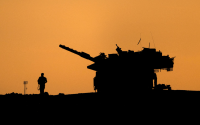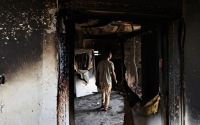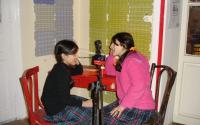7 January 2008Claudia Lefko
I imagine I am not alone in despairing at the end of the year. While others look forward, I am haunted by what we did not accomplish in 2007. Particularly devastating is the ongoing war and occupation in Iraq, and the toll it continues to take on all of us, but particularly on the civilian population in Iraq, most especially on children.
I was humbled to receive a holiday greeting from Dr. Salma in Baghdad with her wish for peace in 2008. How do these Iraqis continue to hold onto hope! Then came an appeal and photographs from southern Iraq, asking me to support a non-violence training project. Children and youth in Al-Samawa are being asked to turn in their toy guns for balls and other toys. The photographs showed two men and a long line of children holding their toy guns. Next to them you see the balls and the pile of already cashed-in guns. Again, I am moved. What resilience in this gesture, given the depth of the problem facing parents in Iraq and in other war zones around the world.
I spent Christmas 2003 working on an art exchange project and taking photographs of children on Dr. Salma’s cancer ward in a pediatric hospital in Baghdad. One day I was confronted by a small child wielding a toy gun, and gesturing for a photograph. I stopped and stared at the child in horror, a sinking feeling sweeping over me as he struck his pose and waited for the click of my shutter. I realized immediately that this would be a photograph with a “message”: this is what happens to children growing up surrounded by war and violence.
But what message would I give the child by taking this photograph? I would be affirming his pride in the toy gun, giving my unspoken support, my consent. I would legitimize his war game, which, like all children’s games, is practice in preparation for a future in an adult world. I didn’t want to immortalize an Iraqi child in this horrifying posture. I turned and walked away, leaving him standing in obvious disappointment.
A year later a friend handed me the January 22, 2007 Newsweek Magazine with “my photograph” on the cover. A small, serious looking Iraqi boy poses with a toy gun and stares from a white background. Above his head, in bold letters the caption: The Next Jihadists.
Inside, on page 24, is a fold- out photo of 13-year-old Ammar with his –real–Kalashnikov assault rifle. In letters that take up nearly half the facing page the title reads: Iraq’s Young Blood. It was another sickening moment for me. There was “my” photograph, but the gun is real. And the message not so much a sad lament about the tragedy of what is happening to Iraq’s children, as a warning against them.
Iraq’s children need to be rescued, not feared. They are the best hope and most important resource of any country, yet they continue to suffer and die out of sight and out of mind of most of us. SAVE the Children’s report: State of the World’s Mothers 2007, Saving the Lives of Children Under 5 shows Iraq continues to have the highest Under 5 mortality (U5MR) of any country in the world. Since the first Gulf War, the U5MR has increased a staggering 150%. It is estimated that one out of every eight children in Iraq dies before their fifth birthday: 122,000 children died in 2005.
According to UNICEF, some two million children “…continued to face threats including poor nutrition, disease and interrupted education” in 2007. Only 20% of Iraqi children outside of Baghdad have access to safe drinking water or proper sewage treatment facilities. Seventeen percent of Iraqi children are permanently out of primary school and an estimated 220,000 more are missing school because they and their families have been displaced. These are in-country figures and don’t include the hundreds of thousands of Iraqi children and youth whose education is interrupted or ended because their families have fled to other countries.
Children are developing, each stage of their growth and development is a critical building block that enables them to reach the next stage. In order to achieve their potential–physically, emotionally, intellectually–their needs must be met at each stage. The lack of food, clean water, shelter, education and access to health care adds up to–at best– a compromised future.
Somehow, this ongoing crisis for Iraqi children continues to escape the mainstream media. Iraq is a never ending sporting event, with sides developing strategies, making gains and suffering set backs. The real losses suffered by Iraqi children, day after day and year after year are rarely added up and taken into account and almost never reported on.
“Children are both our reason to struggle to eliminate the worst aspects of warfare, and our best hope for succeeding at it.” wrote Graca Machel, the author of a seminal assessment and call to action on their behalf. The UN accepted The Impact of Armed Conflict on Children in a unanimous resolution in 1996. The report affirms the right to special protection and care for children caught in war and conflict zones and reaffirms their rights under international treaties. Iraqi children–and all children in war zones–need the international community to stand by its commitments, and deliver the protection and care that is guaranteed them under international law. Maybe, 2008 will see some much needed action on their behalf.
Claudia Lefko is an educator and longtime activist who is involved in local, national and international efforts that seek to put the well-being of children and their education at the top of the public agenda. She is the founder (2000) and director of the Iraqi Children’s Art Exchange, a project that uses art to connect Iraqi children —across language, culture and politics—to children in the US. Her current work involves arts/education programming for Iraqi refugee children in Amman Jordan.






